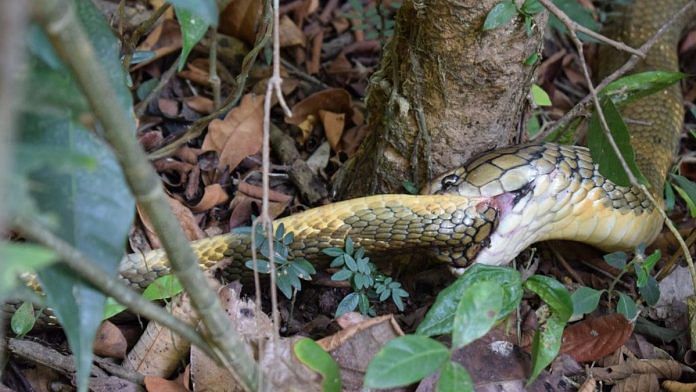Bengaluru: The only available antivenom in India may be ineffective in treating bites from most of the lethal snake species found in the country, a study has found.
The research, published Friday in the PLOS Neglected Tropical Diseases, was conducted by scientists at the Indian Institute of Science’s Evolutionary Venomics Lab along with herpetologists Gerard Martin and Romulus Whitaker.
India accounts for nearly 46,000 deaths from snakebites each year, the highest in the world, besides around 1,40,000 grave injuries.
The antivenom in use in India, a polyvalent derived from the venom of the four snake species responsible for most bites in the country, was found to be ineffective in neutralising the venom of less known but medically important species such as kraits, the study said.
“Only about 60 species of snakes can potentially inflict lethal bites or severe morbidity but we do not fully comprehend the magnitude of the medical problem imposed by these neglected snake species in India,” Kartik Sunagar, the paper’s lead author, told ThePrint.
Explaining the lack of detailed statistics on snakebites in India, Sunagar said, “It is not a notifiable disease in India, victims often don’t see the snake, venom detection kits are mostly unavailable and clinicians are not trained to identify species.”
Also read: These rescuers are saving humans and snakes from each other
Old manufacturing protocols
Despite the problems plaguing the crucial drug, the polyvalent antivenom continues to be derived through a protocol several decades old.
Antivenom is typically known to work when it has been derived from the same species that caused the bite. In India, the process of antivenom manufacture is problematic because it is derived from the venom of the ‘Big Four’ snake species and is only effective against bites from these.
The country, however, is home to over 270 species, 60 of which are venomous.
Snakebites are among the world’s most neglected tropical diseases (NTD), with the World Health Organisation (WHO) estimating that there are more than 27 lakh cases annually and 5 lakh deaths or permanent disabilities. Half of the snakebite-caused deaths occur in India alone.
How is antivenom created
Antivenom is made by injecting venom in small doses into the bodies of animals such as horses, cows and goats. The antibodies produced by these animals against the venom are then collected and processed for purification.
The first antivenom was developed in 1895 by Albert Calmette against the Indian Cobra.
In India, only horses are used for antibody production and the venom utilised is a combination of those collected from the ‘Big Four’ species — the spectacled cobra, common krait, Russell’s viper, and saw-scaled viper. Manufacturers source most of the venom from the Irula Snake Catchers Industrial Cooperative Society in Tamil Nadu.
An antivenom binds with the venom proteins and neutralises their toxicity. However, each species and sub-species of snakes displays variation in the protein composition of venom.
Also read: Modi govt to soon roll out a national policy to tackle problem of stranded marine animals
‘Weak antivenom’
Researchers in this study collected venom from 45 individual snakes belonging to seven different species, including the Sochurek’s viper, Sind krait, banded kraits, and monocled cobra.
The study involved an ‘in vitro’ exam to determine the antivenom’s binding ability and then tested its efficacy on mice.
The researchers found that the polyvalent antivenom made by four different manufacturers in India displayed varying degrees of binding abilities. They also found that, in mice, the antivenom failed to neutralise venom from the Sind krait and two populations of the monocled cobras, which are all close relatives of the ‘Big Four’.
They also found that venom from Sind krait was six times more potent than the common krait’s and 40 times more lethal than the common cobra’s.
Variations in the composition of venom across geographical regions was to blame for the drug’s inefficacy, the study said. The antivenom compositions were also found to contain up to 10 times fewer antibodies than some of their global counterparts.
The drug was also unable to counter venom produced by the north Indian common krait — one of the ‘Big Four’ species for which it was created.
“Crude venom is used for immunisation of horses… it contains other non-toxic proteins found in the saliva of the snake, as well as toxins that are not dangerous to humans but only effective against the natural prey or predators of snakes. In addition, the venom may also contain impurities,” said Sunagar.
Venom composition in snakes is also highly dependent on creatures they prey upon. There have been instances when toxicity of venom has evolved in varying degrees to counter non-mammalian prey. Venom of the banded krait and Sochurek’s viper, for example, are least potent against mammals but fatal for non-mammals.
“Therefore, immunising horses with this raw cocktail of venom for antivenom production subsequently reduces the abundance of therapeutically important antibodies,” Sunagar added.
Also read: World’s largest eagle ‘rescued’ in Odisha, but experts say ‘doesn’t look like it’
More venom collection centres needed
Scientists are yet to map the variations of toxicity in venom from snakes belonging to various species and geographical locations, and variations within the same species in similar regions.
If the antivenom isn’t effective against common kraits in northern India, does it work effectively against those in other regions? Do snakes kept in captivity by antivenom manufacturers differ in venom composition to those in the wild?
Sunagar and his team at the Evolutionary Venomics Lab hope to answer many such questions.
“Producing a recombinant antivenom that selectively targets all of the clinically important toxins would be a step forward for the snakebite therapy in India,” he said.
For the time being, Sunagar suggests the government invest in venom collection centres across the country to manufacture regionally effective antivenoms. It would increase efficacy of the drug against bites by different varieties of snakes.



